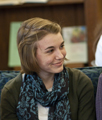Web Extras for “How to Read a Contemporary Poem” by Nigel Alderman
Poetry is, of course, a multifaceted art form; below we present a tiny sample of the many ways you can experience it.
- Eavesdrop on Emily Yates ’11 as she creates a new poem (and reads the finished product)
- Listen to MHC Professor of English Robert B. Shaw read his poems.
- Learn more about the Quarterly article’s writers.
- Discover more about poetry on sites recommended by MHC Assistant Professor of English, Nigel Alderman.
- Investigate new ways of creating and enjoying poetry.
Eavesdrop on the process of creation as Emily Yates ’11 writes a new poem.
Below, Emily Yates explains the process by which she created a new poem, “Doubt.” You can peek over her shoulder during the process by looking at each of the four drafts this poem went through.
“My intention in this poem was to explore people’s curiosity and uncertainty about death. Despite this dark subject matter, I didn’t want the overall feeling of the piece to be depressing or violent; instead I was hoping to capture a childlike wonder of the mysteries of the world and a search for knowledge.
“The first two drafts seemed aggressive and forceful; the I and the you shared the search for answers and it ended in mutual destruction. In the third revision, I experimented with the I figure, making it a foil to the you, but I felt this change put too much weight on the I. Finally, I removed the I figure from all but the last stanza, which I think refocused and softened the poem.
“I am still not satisfied with the final stanza, which seems vague and generic, but the revision process is never truly finished.”
Hear Emily Yates read her poem “Doubt.”
Listen to MHC Professor of English Robert B. Shaw read his poems.
“A Geode” from Below the Surface, 1999, used by kind permission of Copper Beech Press.
“A Pair of Bookends,” from The Post Office Murals Restored, 1994, used by kind permission of Copper Beech Press.
“Out of Character” from Solving for X, 2002, used by kind permission of Ohio University Press.
“Paper Birch” from Below the Surface, 1999, used by kind permission of Copper Beech Press
Learn more about the poetry article’s writers.
Nigel Alderman specializes in twentieth-century British literature with a more general interest in romantic and post-romantic poetry and poetics. He is currently finishing a book, Transitional Forms, on English Literature of the 1960s, that examines the turn from myth construction to historiographic investigation in the works of Doris Lessing, Muriel Spark, Harold Pinter, Peter Brook, Geoffrey Hill, and Ted Hughes. Read More
Robert B. Shaw is the author of four poetry collections, the most recent of which is 2002’s award-winning Solving for X. His academic specialties, in addition to writing poetry, include modern British and American poetry, seventeenth-century literature, and American Southern literature of the twentieth century. Read more
Discover more about poetry on sites recommended by MHC Assistant Professor of English Nigel Alderman.
LOCAL RESOURCES
Mount Holyoke Faculty Poets
- Robert Shaw, professor of English
- Ronaldo Wilson, visiting assistant professor of English
- Sara London, visiting lecturer in English
The Glascock Intercollegiate Poetry Contest
The Poetry Center at Smith College
Resident Poets at UMass-Amherst
GENERAL SITES:
The Academy of American Poets’ official site lets you search by poet or poem, and includes an archive of audio and video, essays and interviews, and its “mobile poetry” section gives you access to 2,500 poems on your mobile phone.
Also: The University of Pennsylvania’s Center for Programs in Contemporary Writing has a free (and extensive—1,500 poems so far) MP3 audio archive. PennSound includes both decades-old recordings (including Ezra Pound and Allen Ginsberg, for example), and contemporary poetry readings.
INDIVIDUAL POETS
Carol Ann Duffy – (first female poet laureate)
Louise Glück (winner of Pulitzer Prize)
Paul Muldoon
On the Colbert Report
Investigate new ways of creating and enjoying poetry.
1. Flarf poetry, one of the new century’s most controversial poetry movements, arranges words collected in unusual Internet searches to create text collages. Read about it in the Poetry Foundation’s piece “Flarf and Conceptual Writing in Poetry Magazine.”
2. Erasure poetry Writers using this form believe that less can be more. Take any text and erase words and punctuation from it to create a new poem. Try it here.
3. Action poetry One form of art inspires another: video artists create visuals to go with a poem. See the collection here. An especially lovely example is the collection of videos set to poems by past Poet Laureate Billy Collins’s “Forgetfulness.”
4. Weird Deer recorded poetry lets creative types everywhere have recordings of their works posted online for the world to see and hear. The site welcomes material “in whatever form manifests [the creator’s ideas] best—an interview, a video diary, a letter, an e-mail, a poem, a story, a lie, a text message, an image, a book, a matching piece of trash, whatever.”
April 2, 2010







